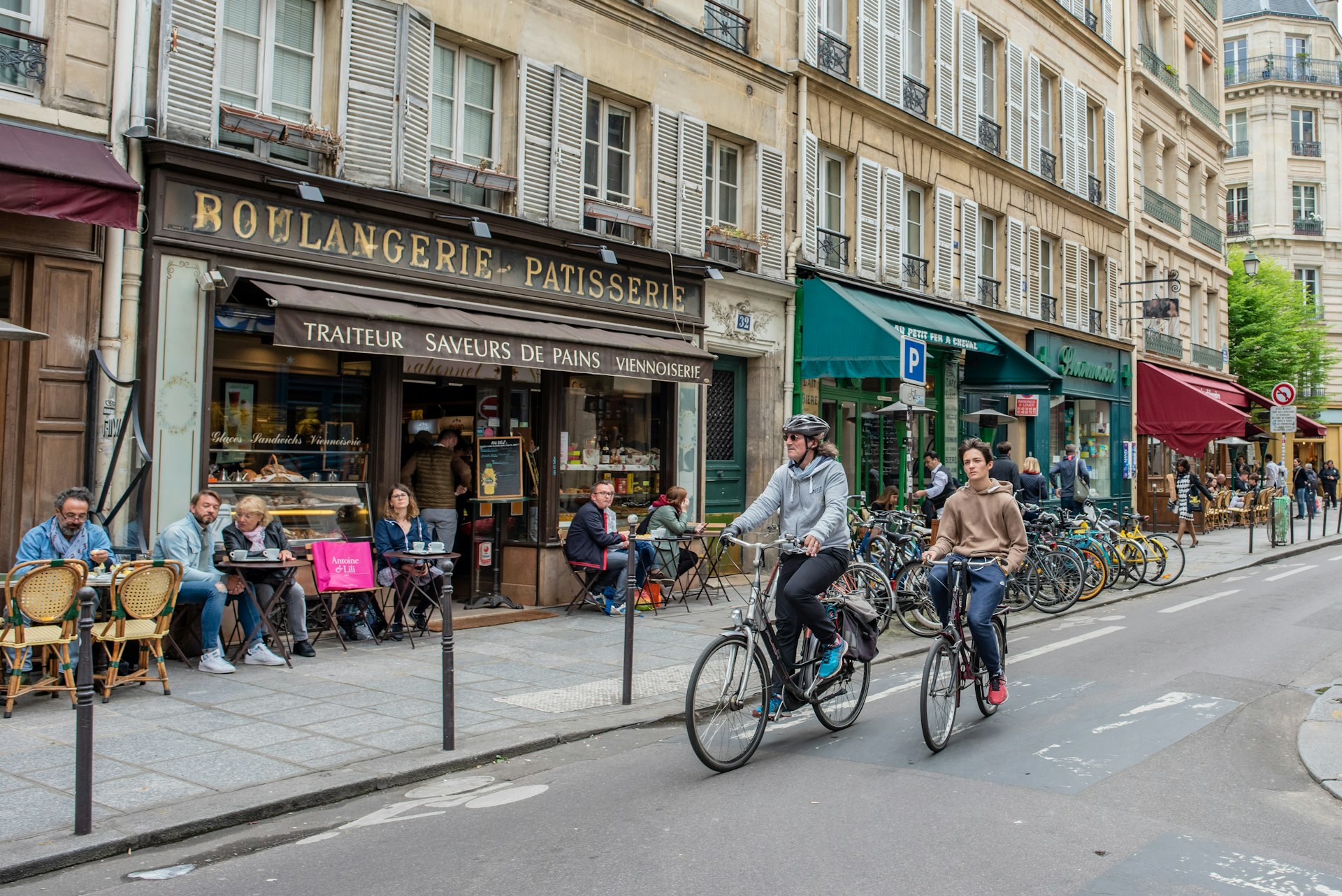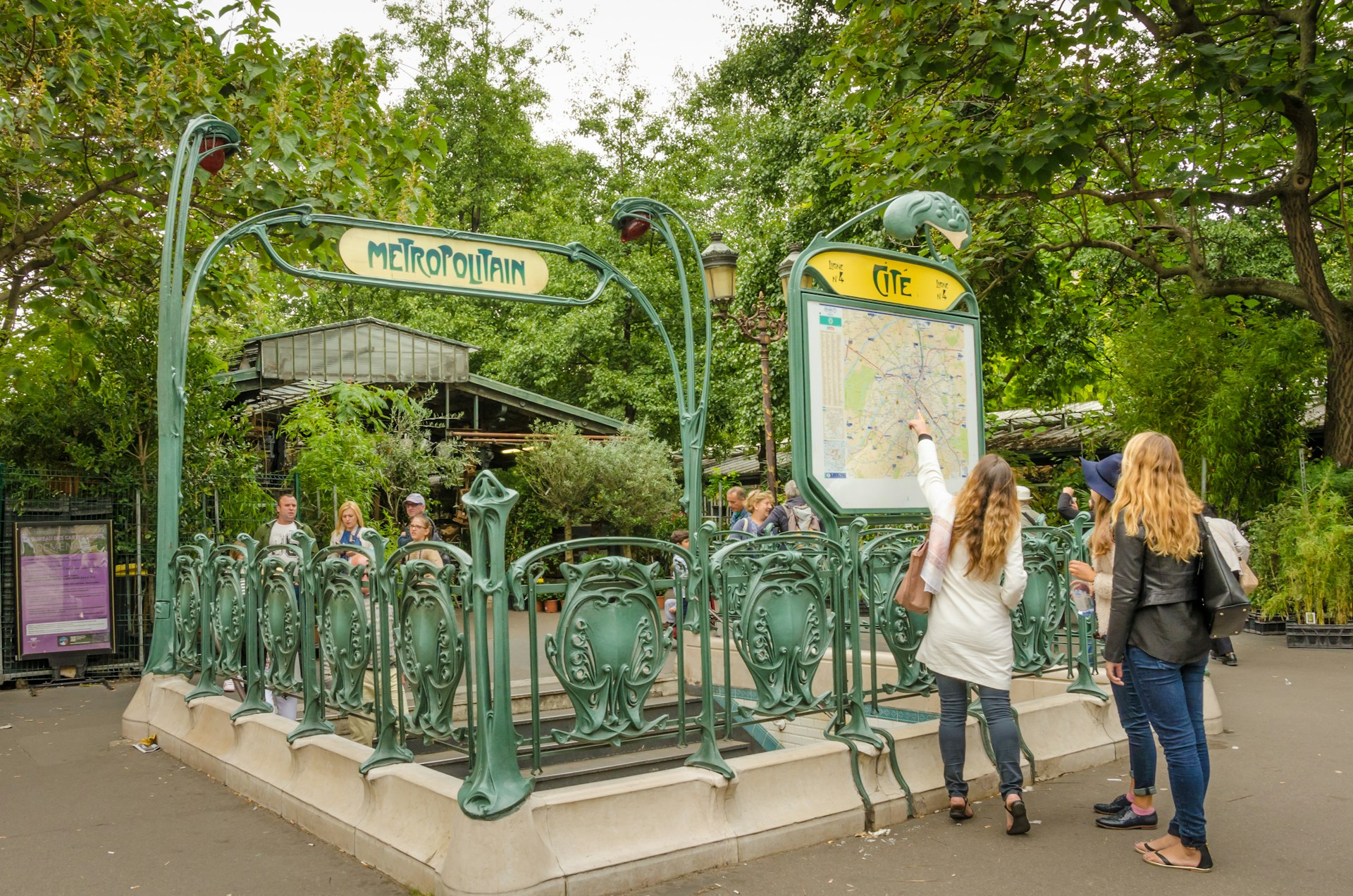Paris serves up an almost endless sampling platter of iconic things to see and do – from the Eiffel Tower and Cimetière du Père Lachaise to the foodie treats of the Marché Bastille street market. But the City of Lights covers 105 sq km (40.5 sq miles), so you'll need to get to grips with the city's extensive public transport network to make the most of this magnificent European capital.
The weather will play a big part in how you choose to explore Paris. The city was made for walking, but winter can make for chilly strolls along the Seine and frosty hikes up the hill to Montmartre. Luckily, the Paris metro is warm year-round, and you can also turn to taxis, trains, bikes, boats and buses.
Ready to explore France's most romantic city? Here’s our handy guide to getting around in Paris.
Public transport tickets and passes
If you’re staying in Paris for longer than a few days, the cheapest and easiest way to use public transport is to get a combined travel pass that allows unlimited travel on the metro, the RER (Réseau Express Régional) train network and buses for a week, a month or a year. Mobilis day tickets and Paris Visite tourist passes cover public transport for all of the Île-de-France (that is, all zones).
Mobilis passes last for 24 hours and cost from €7.50 for two zones to €17.80 for all zones. Paris Visite passes cover transport and also give discounted entry to major sights; buy a "Greater Paris" pass to reach the airports, Disneyland Paris and Château de Versailles. Paris Visite passes are available for one to five days of travel – a one-day pass costs €12 (€25.25 covering Greater Paris).
Alternatively, you can pay for journeys using Navigo. Like London’s Oyster card or Hong Kong’s Octopus card, this system provides you with a refillable weekly, monthly or yearly pass for travel on the metro, RER trains and buses, that you can recharge at machines in most metro stations. To pass through the station barrier, swipe the card across the electronic panel as you go through the turnstiles.
Standard Navigo cards, available to anyone with an address in Île-de-France, are free but take up to three weeks to be issued; ask at the ticket counter for a form or order online via the Navigo website. An easier option for tourists is the €5 Navigo Découverte (Navigo Discovery) card, which is issued on the spot but is not replaceable if lost or stolen. Both passes require a passport photo and can be recharged for periods of one week or more.
A weekly pass costs €22.80 and is valid Monday to Sunday. It can be purchased from the previous Friday until Thursday. Even if you’re in Paris for three or four days, it may work out cheaper than buying carnets (books of tickets) and will certainly cost less than buying a daily Mobilis or Paris Visite pass.
The monthly pass (€75.20) begins on the first day of each calendar month; you can buy one from the 20th of the preceding month. Both are sold in metro and RER stations from 6:30am to 10pm and at some bus terminals.

Walking through Paris
Paris is a beautiful city to explore on foot, with many of the city's top attractions within easy walking distance if you’re staying centrally. However, winter is marked by cold, rainy days that can take some of the gloss off romantic walks along the banks of the Seine.
At any time of year, be aware of distance when walking between the sights. It's a 3.5km (2.2 mile) walk from the Eiffel Tower to the Louvre, which is more enjoyable in spring and fall than in the depths of winter or the heat of peak summer.
Even if your accommodation is further away, make time for a walk around your local arrondissement (district) before leaping on public transport to the center – it's the things you discover by accident while aimlessly wandering at street level that make Paris one of the world's most charming cities.
Paris by bike
Paris is increasingly bike-friendly, with a growing network of cycling lanes – part of a concerted effort by the Paris city authorities to reduce the number of cars on the roads. However, take extra care if you're not used to driving on the right, and be aware that drivers in Paris may give cyclists less space than you're used to back home. Also, watch out for pedestrians at road crossings – the surging popularity of cycling in Paris has led to some problems balancing the needs of cyclists and pedestrians.
Many bike shops rent out bicycles, but the Vélib' bike-share scheme puts tens of thousands of bikes (30% of which are electric) at the disposal of Parisians and visitors at some 1400 stations throughout Paris, accessible around the clock. To get a bike, you first need to purchase a one- or seven-day subscription either online (generally EU credit cards only) or on the spot at the docking station.
After you authorize a refundable deposit (€300) to cover the cost of the bike should it go missing, you’ll receive an ID number and PIN code and you’re ready to go. Bikes are rented in 30-minute intervals. If you return a bike before a half-hour is up and then take a new one, you will not be charged for a standard bicycle (electric bikes incur charges).

Buses are inexpensive and frequent
Buses can be a highly rewarding way to get around, if only because of the views – you'll certainly see much more than you would from the metro. And there are no stairs to climb, meaning buses are more accessible to the mobility impaired – but they’re slower and routes are less intuitive than the straightforward and logical metro.
Paris’ bus system, operated by the RATP, runs from approximately 5am to 1am Monday to Saturday; services are drastically reduced on Sunday and public holidays. Hours vary substantially depending on the route.
Paper tickets are due to be phased out by 2022, replaced by contactless cards. Normal bus rides embracing one or two bus zones cost the equivalent of one metro ticket; longer rides require two or even three tickets.
Whatever kind of single-journey ticket you have, you must validate it in the ticket machine near the driver. If you don’t have a ticket, the driver can sell you one for €2 (correct change required).
The Paris Metro: the definitive way to explore
Paris’ urban mass transit network is run by RATP and consists of two separate but linked systems: the metro and the Réseau Express Régional (RER) suburban train line. The metro has 14 numbered lines; the RER has five main lines (but you'll probably only need to use A, B and C).
When buying tickets consider how many zones your journey will cover; five concentric transport zones ripple out from the center of Paris (zone 5 being the furthest from the center); if you travel from Charles de Gaulle Airport to Paris, for instance, you will have to buy a ticket for zones 1 to 5.
Metro maps of various sizes and degrees of detail are available for free at metro ticket windows; several can also be downloaded for free from the RATP website. The RER is faster than the metro, but the stops are much further apart. Some attractions, particularly those on the Left Bank (eg the Musée d’Orsay, Eiffel Tower and Panthéon), can be reached far more conveniently by the RER than by the metro.

Metro lines are identified by both their number (eg ligne 1 – line 1) and their color, listed on official metro signs and maps. Direction signs on each platform indicate the direction of travel. On lines that split into several branches (such as lines 7 and 13), the terminus of each train is indicated on the cars and on signs on each platform giving the number of minutes until the next train.
Signs marked correspondance (transfer) show how to reach connecting trains. At stations with many intersecting lines, like Châtelet and Montparnasse Bienvenüe, walking from one platform to the next can take a long time. Different station exits are indicated by white-on-blue sortie (exit) signs. You can get your bearings by checking the plan du quartier (neighborhood maps) posted at exits.
Each line has its own schedule, but trains usually start running at around 5:30am, with the last train beginning its run between 12:35am and 1:15am (2:15am on Friday and Saturday), with all-night services under consideration.
If you’re going out to the suburbs (eg Versailles or Disneyland), ask for help on the platform – finding the right train can be confusing. Also, make sure your ticket is valid for the correct zone – the metro has an extensive and costly system of fines, covering everything from not having the correct ticket for your ride to accidentally leaving a bag on the train!
Exploring Paris by car or motorbike
Driving in Paris can be a high-stress experience. With the hassles of the tricky road layout, heavy traffic, limited parking and the general shortage of petrol stations, you're better off avoiding driving completely. Public transport will cover all your needs downtown, but if you’re heading out of the city on an excursion, a car can be useful. A Crit'Air Vignette (compulsory anti-pollution sticker) is also required in most instances. If you plan on hiring a car, it’s best to do so online and in advance – the usual operators are represented in town and at the airports.
To enter the city within the Boulevard Périphérique (ring road) between 8am and 8pm Monday to Friday, a Crit'Air Vignette (compulsory anti-pollution sticker) is needed for all cars, motorcycles and trucks registered after 1997, including foreign-registered vehicles. Older vehicles are banned during these hours. The sticker is not necessary for the ring road itself.
There are six color-coded stickers, ranked according to emissions levels, from Crit'Air 1 to the highest-polluting Crit'Air 6; prices start at €3.62. In instances of elevated pollution levels, vehicles with stickers denoting higher emissions are banned from entering the city. Fines for not displaying a valid sticker start at €68.
You can order stickers online via the website, with instructions in multiple languages including English. You'll need to upload a copy of your vehicle's registration certificate. Allow time for it to be mailed to your home.

Taxis in Paris
Taxis can be flagged down in the street in Paris, but it's easier to find a taxi at an official taxi stand. However, rides are not cheap; flagfall is €4 (€7 for advance bookings) and a colored light on the meter indicates the class of fare in operation at the time of travel.
Within the city limits, rides cost €1.12 per kilometer for travel between 10am and 5pm Monday to Saturday (Tarif A, indicated by a white light on the taxi roof and meter). At night (5pm to 10am), on Sunday from 7am to midnight and during peak travel times (7am to 10am and 5pm to 7pm Monday to Saturday) in the central 20 arrondissements, the rate is €1.38 per kilometer (Tarif B; orange light).
Travel in inner Paris on Sunday night (midnight to 7am Monday) and in the outer suburbs is at Tarif C, €1.61 per kilometer (blue light). The minimum taxi fare for a short trip is €7.30. There are also flat-rate fares to/from the major airports (Charles de Gaulle from €53, Orly from €32).
To order a taxi, call or reserve online with Taxis G7 or Alpha Taxis. An alternative is to order an Uber rideshare; fares are comparative with official taxis (and sometimes cheaper) and drivers come quickly.
Boats along the Seine
Batobus runs glassed-in trimarans that dock every 20 to 25 minutes at nine small piers along the Seine: Eiffel Tower, Invalides, Musée d’Orsay, St-Germain des Prés, Notre Dame/Latin Quarter, Jardin des Plantes, Hôtel de Ville, Musée du Louvre and place de la Concorde. They're a useful, scenic way to get explore the riverbanks.
Buy tickets online, at ferry stops or at tourist offices. Passes valid for 24-hours travel start at €19/9 (adult/child). Two-day passes must be used on consecutive days.
Accessible transportation in Paris
Paris has grown up over centuries and the city is not particularly well set up for visitors with disabilities. Curb ramps are few and far between, older public facilities and budget hotels usually lack lifts, hotel rooms in general are tiny, and the metro – dating back more than a century – is mostly inaccessible for people who use wheelchairs.
Efforts are being made to improve things, however. The tourist office continues its excellent Tourisme & Handicap initiative, with special logos displayed at museums, cultural attractions, hotels and restaurants that provide access, special assistance or facilities for those with physical, cognitive, visual and/or hearing disabilities. On the Paris Info website, you can use the FACIL'iti service to create your own profile to personalize content according to your particular motor, sensory and/or cognitive needs.
The Paris Convention and Visitors Bureau’s main office at Hôtel de Ville (City Hall) is equipped with a service called ACCEO, which makes it possible for people who are deaf or hearing impaired to ask for information with the help of a French sign-language operator. You'll find more information on accessible travel on Lonely Planet's Accessible Travel Resources page.
You might also like:
Your essential guide to the arrondissements of Paris
Gourmet on the go: the best street food in Paris
Top things to do in Paris


